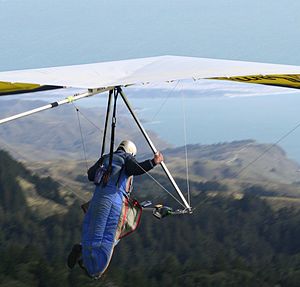Unpowered aircraft
This article needs additional citations for verification. (December 2022) |

Unpowered aircraft can remain airborne for a significant period of time without onboard propulsion. They can be classified as
History
The first manned aircraft were kites, balloons and gliders. Man-lifting kites were used in ancient China and Japan, often as a punishment for prisoners. Unmanned hot-air balloons and toy "bamboo-copters" are also recorded in Chinese history.
The first manned free flight was in a hot-air balloon built by the brothers Joseph-Michel and Jacques-Etienne Montgolfier in Annonay, France in 1783. The hydrogen balloon appeared at about the same time and proved more practical.
The first practical, controllable glider was designed and built by the British scientist and pioneer George Cayley who many recognise as the first aeronautical engineer.[2] It flew in 1849.
Tethered balloons and, to a lesser extent, kites were developed for military and meteorological observation, however the use of kites has remained largely recreational. Free-flying ballooning using coal gas (which has about half the lifting effect of hydrogen) became a popular sport. Gliders were used mainly for aerodynamic research until their sporting use was developed in the 1920s.
During the two World Wars, tethered barrage balloons were made and deployed in large numbers. Military assault gliders were also developed during World War II, while the rotor kite was used by the German Navy for seaborne observation.
Modern applications include experimental
Gliders
Sailplanes, hang gliders and paragliders are all types of glider aircraft.
For a glider to generate lift, it must first gain and then maintain sufficient forward air speed.
Launching a glider gives it the initial forward airspeed to start flying. This is often done by towing the aircraft into the air on a long line, using either a ground-based winch or vehicle, or a powered "tug" aircraft. A small foot-launched glider is launched by running downhill or stepping off a high location.
Forward speed is then maintained by a gradual descent through the surrounding air, with the wings angled slightly down so that their lift also provides a small forward thrust to counter the drag of the wing.
If the air is rising faster than the aircraft is descending through it, the glider will gain height and additional potential energy. Sources of such rising air include warm thermals and hill ridges.
In the past, unpowered military gliders have been used for military applications.
Today, the majority of use of all types of glider aircraft is recreational.
Balloons
Free-flying
A round tethered balloon is unstable in any significant wind. A kite balloon is streamlined to make it stable in strong winds.
Today, the majority of manned balloon flights are recreational, whereas unmanned and usually free-flying balloons are widely used for meteorological measurement.
Kites
Kites are aircraft
See also
- Kite types
- Gliding
- Gliding competitions
- Gimli Glider, a passenger jet aircraft that ran out of fuel
- Gyroglider
- Colditz Cock, a glider built to escape from Colditz
References
- ^ System and method for wind-powered flight Dale C. Kramer
- ISBN 978-0-7710-2971-4.
- ^ "Kites". NASA. Retrieved 2009-03-18.
External links
- Fédération Aéronautique Internationale This is the world organisation for air sports such as gliding, hang gliding and paragliding
